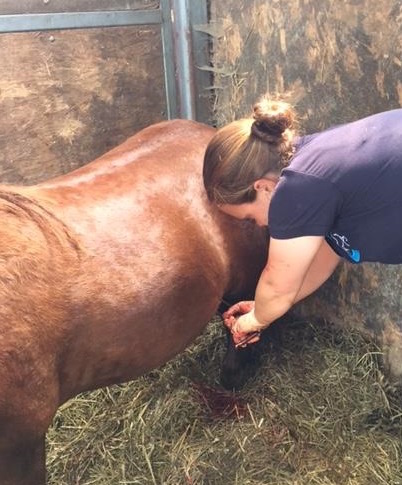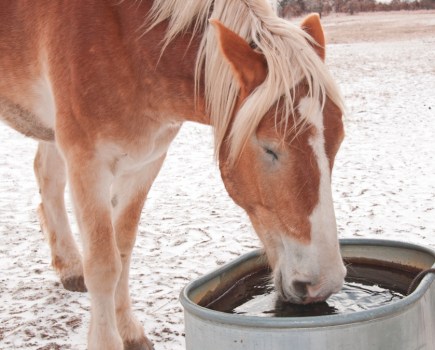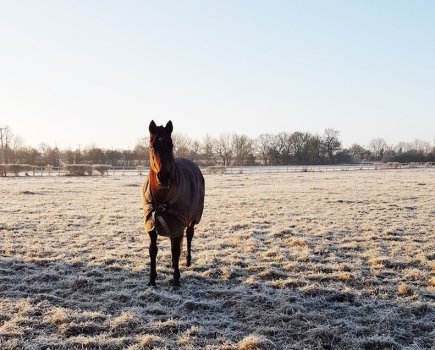Castrating a horse is a common procedure, but not something we’re all familiar with. To explain how it’s done and what to expect is XLVets Equine’s Beth.
Having spent all winter praying for warmer weather and the sunshine to finally arrive, it’s now here and we’re all moaning that it’s too hot!
With last Wednesday being the hottest day of the year so far, my colleague Heather and I were less than thrilled to see seven castrates booked in our diary.
Castrating is hard work at the best of times, but in this heat with four of the colts virtually unhandled, we definitely needed a shower afterwards!
How are horses castrated?
The majority of colts are castrated under standing sedation. This means it can be done on the yard.
Because it’s not possible to be completely sterile while performing this procedure, we don’t close the surgical incision and instead leave it open to drain.
This also means that we cannot suture the blood vessels to stop bleeding, as the suture material could become contaminated and be the source of an infection.
For this reason, it’s riskier to castrate horses with larger blood vessels and therefore a higher risk of bleeding using this technique, for example older horses, larger horses and those that have covered mares.
For these horses, we suggest performing a closed castration with a ligature on the blood vessels and suturing of the skin and is performed in the clinic under general anaesthesia.
How long does it take to castrate a horse?
A routine castration usually takes between 45 and 90 minutes from start to finish.
We briefly check each horse over to make sure they’re fit and well and have two descended testicles and then we heavily sedate them.
We inject them with a pain killer, an antibiotic and tetanus antitoxin.
At this point it’s really useful if the horse is well handled and used to their owners ‘having a feel’!
We need to administer the local anaesthetic, this is the most difficult part and often when we get kicked.
The castration procedure
We have to hold the testicle and put a long needle into it to inject half the anaesthetic to relax the muscle and numb the area, the second half of the local goes into the skin so they can’t feel us making the incision.
This has to be done on both sides and usually the horse gets wise to it by the second side and isn’t best pleased!
Once this is done, our lovely nurses give the area a scrub while we put on our sterile gloves and grab a blade, which is when we find out whether we did a good job with the local anaesthetic (!).
We hope the horse can’t feel it and stands nice and still while we cut through all the layers down to the testicle.
We then squeeze it out and separate the blood vessels and spermatic duct and connective tissue.
We clamp the two parts separately with the emasculators, which is the part that makes the crunching sound – making all the boys watching cross their legs!
The emasculators clamp the blood vessels as well as cutting the tissues and we leave them on for at least two minutes to let the blood vessels clot.
I put on some small forceps before taking them off so that if the blood vessel starts bleeding again it’s easier for me to grab it, but this is personal preference.
Once both sides are done, I check there isn’t excessive bleeding and then remove the forceps.
The rule is that if you can count the drops of blood then that’s ok, but if they get too fast to count you need to call us back.
I recommend 24 hours of box rest to make sure there’s no further bleeding and then plenty of gentle exercise to minimise swelling and reduce the risk of infection.
What are the risks?
A recent study performed by a major equine hospital in Newmarket found that the risk of complication in standing castration is a staggering 22%.
This includes anything from minor bleeding and skin infections, to major infections, peritonitis and eviscerations (the intestines coming out through the wound).
For this reason as a newly graduated vet I find castrates a little nerve wracking, especially as owners often perceive it as a routine and therefore a fairly low-risk procedure.
This means that even if you do everything right, your patient may be the one in five that’s unlucky and develops a complication and you tend to end up with a very unhappy owner.
In comparison castrations performed in theatre under general anasesthetic had only a 6% complication rate but were three times more expensive, definitely a disadvantage!
I hope I haven’t managed to completely terrify anyone with entire colts, but it definitely makes interesting food for thought.









